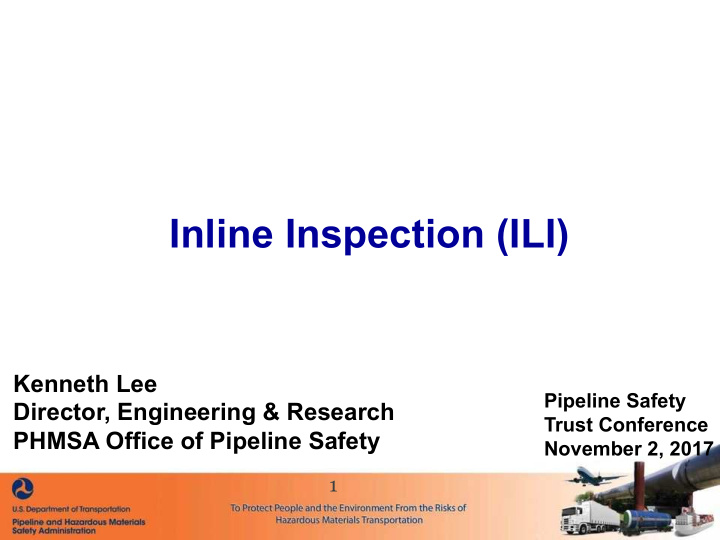



Inline Inspection (ILI) Kenneth Lee Pipeline Safety Director, Engineering & Research Trust Conference PHMSA Office of Pipeline Safety November 2, 2017 1
Pipeline Challenges • United States has the oldest, most extensive pipeline system in the world • Increasing population near pipelines • Increasing pipeline mileage • Large variation in pipeline population (diameter, wall, grade, seam type, etc.) • Many types of imperfections 2
3 3
Aging Infrastructure 4 4
Aging Infrastructure (% by Decade in USA) Hazardous Liquid Pipeline Vintage 183,000 miles 55% installed prior to 1970 25% 20% 15% 10% 5% 0% < 1940 1940s 1950s 1960s 1970s 1980s 1990s 2000s 5 - 5 -
Aging Infrastructure (% by Decade in USA) Gas Transmission Pipeline Vintage 59% installed prior to 1970 25% 20% 15% 10% 5% 0% < 1940 1940s 1950s 1960s 1970s 1980s 1990s 2000s 6 - 6 -
Gas Transmission 7
Hazardous Liquid 8
Pipeline Safety with Context Measures (1988-2016) Index (1988 = 1) Natural Gas Consumption (Trillion Cubic Feet Per Year) 1.4 Petroleum Product Consumption (Million Barrels Per Day) 1.2 Pipeline Mileage 1.0 0.8 U.S. Population (Millions) 0.6 Incidents with Death or Injury 0.4 0.2 Major Hazardous Liquid Spills 0.0 1986 1988 1990 1992 1994 1996 1998 2000 2002 2004 2006 2008 2010 2012 2014 2016 Data Sources: Energy Information Administration, Census Bureau, PHMSA Incident Data as-of February 28, 2017 Calendar Year Pipeline Mileage as-of March 26, 2017 (assumes 5,000 mile increase for Hazardous Liquid in 2016) 9 9
Recent Incidents Carmichael, MS Marshall, MI Santa Barbara, CA 10
Recent Incidents where NTSB identified inadequacies in ILI • 2007 Carmichael, MS (propane, 2 fatalities) – Current inspection and testing programs are not sufficiently reliable to identify features associated with longitudinal seam failures of ERW pipe prior to catastrophic failure in operating pipelines. • 2010 Marshall, MI (crude oil) • 2015 Santa Barbara, CA – The in-line inspection (ILI) tool and subsequent analysis of ILI data did not characterize the extent and depth of the external corrosion accurately. 11
NTSB: 2007 Carmichael, MS Report Recommendation Conduct a comprehensive study to identify actions that can be implemented by pipeline operators to eliminate catastrophic longitudinal seam failures in electric resistance welded (ERW) pipe; at a minimum, the study should include assessments of the effectiveness and effects of in-line inspection tools, hydrostatic pressure tests, and spike pressure tests; pipe material strength characteristics and failure mechanisms; the effects of aging on ERW pipelines; operational factors; and data collection and predictive analysis. (P-09-1) 12
13
Track Record of In-line Inspection as a Means of ERW Seam Integrity Assessment • 2012 Kiefner & DNV Report • Identified significant weaknesses in ILI tools: – Unreliable defect sizing accuracy – Missed defects – Inconsistent failure stress calculations • More rigorous tool verification of tool performance is needed 14
PHMSA Funded Research Courtesy: CRC Evens Courtesy: Pipetel Technologies Courtesy: LASEN Courtesy: ITT Kodak Guided Wave Ultrasonics Courtesy: Pure Gas/Liq Leak Technologies Leak Detection by Fixed Detection Wing/ Helicopter along pipeline 15 Hand-Held Tools for In-Ditch Inspections
Figure 3 Dual magnetization tool- two- Figure 1 Remote-Field magnetizer and caliper Figure 2 Mechanical Damage Eddy Current Testing arm Inspection Using Magnetic Flux Leakage Technology Figure 6- Electro- magnetic acoustic Figure 4 SmartBall- transducer Figure 5- ILI pull test winch free swimming acoustic tool for liquid pipeline leak detection 16
Inline Inspection • One of the requirements of Integrity Management in High Consequence Areas: – Part 192 Subpart O – §195.452 • Must follow ASME B31.8S for selecting appropriate tool for covered segment • Corrosion & other threats • Baseline Assessment • Periodic Assessments 17
No tool is “Perfect” • Each tool is designed to detect a specific imperfection type, size and orientation • All tools have: – < 100% POD (Probability of Detection) – < 100% accuracy: Sizing error (tool tolerance) – Limitations of indirect inspection method, direct inspections needed to validate results 18
X No one tool Multiple tools does it all are needed 19 19
20 20
Summary • ILI is an important part of effective Integrity Management programs • ILI is a valuable tool, has seen much improvement and needs more improvement • PHMSA supports technologies to improving safety, including ILI • PHMSA supports ILI as part of a comprehensive pipeline safety approach 21
Thank you phmsa.dot.gov kenneth.lee@dot.gov 22 22
Recommend
More recommend